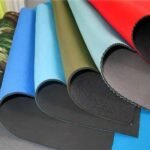When it comes to versatile materials, neoprene and rubber often lead the conversation. Both are used in a wide variety of products, from protective gear to industrial components. But what sets them apart, and which is better for your specific needs? Let’s delve into their unique properties and applications to uncover the differences.
Neoprene and rubber differ in composition, properties, and uses. Neoprene is a synthetic rubber with excellent heat, water, and chemical resistance, while rubber, especially natural rubber, is valued for its elasticity and tensile strength.
Understanding these materials helps you make informed decisions for your projects or product lines. Let’s explore their distinctions in greater detail.
What Is Neoprene and Rubber?
Neoprene and rubber are both flexible materials commonly used for industrial and consumer products. However, their origins and characteristics set them apart.
Neoprene is a synthetic rubber derived from chloroprene, known for its resistance to water, heat, and chemicals. Rubber can be either natural, sourced from latex, or synthetic, made from petroleum-based compounds, offering high elasticity and tensile strength.
Each material has specific properties suited to different applications.
Key Differences in Composition
| Material | Composition | Key Features |
|---|---|---|
| Neoprene | Chloroprene-based synthetic rubber | Water-resistant, heat-resistant, durable |
| Natural Rubber | Latex from rubber trees | Highly elastic, strong, eco-friendly |
| Synthetic Rubber | Petroleum-based compounds | Durable, customizable properties |
These differences in composition explain why each material excels in specific uses.
Which Is Better: Neoprene or Rubber?
The choice between neoprene and rubber depends on the application. Both materials excel in different scenarios due to their unique strengths.
Neoprene is better for applications requiring resistance to heat, water, and chemicals, such as wetsuits or industrial gaskets. Rubber, particularly natural rubber, is ideal for applications needing high elasticity and tensile strength, such as tires or elastic bands.
Both materials are versatile but suited to different environments.
Comparison of Key Properties
| Property | Neoprene | Rubber |
|---|---|---|
| Heat Resistance | Excellent | Moderate |
| Water Resistance | High | Varies (depends on type) |
| Elasticity | Moderate | High |
| Chemical Resistance | Superior | Moderate |
| Cost | Generally higher | Can be lower |
Choosing the right material ensures optimal performance and cost-effectiveness.
How Can You Tell Neoprene from Rubber?
Distinguishing neoprene from rubber can be challenging without knowing their specific properties. However, some simple tests and observations can help.
Neoprene has a smoother, more uniform texture and a distinct resistance to water and chemicals. Rubber, particularly natural rubber, feels softer and has higher stretchability. Synthetic rubber often mimics neoprene but lacks its superior resistance properties.
Understanding these differences ensures the correct material selection.
Methods to Differentiate Neoprene and Rubber
- Texture Test:
- Neoprene: Smoother surface, uniform feel.
- Rubber: Softer, sometimes sticky texture.
- Water Test:
- Neoprene: Repels water effectively.
- Rubber: May absorb small amounts of water.
- Elasticity Test:
- Rubber: Stretches significantly.
- Neoprene: Less elastic but retains shape better.
These simple tests can quickly identify the material type.
Is Synthetic Rubber the Same as Neoprene?
Synthetic rubber and neoprene share similarities but are not the same. Neoprene is a specific type of synthetic rubber with unique properties.
Synthetic rubber includes a broad range of materials made from petroleum-based compounds, including neoprene. Neoprene, however, is distinct for its superior resistance to environmental factors like heat, water, and chemicals.
Understanding this distinction is key to selecting the right material.
Types of Synthetic Rubber
| Type | Key Features | Applications |
|---|---|---|
| Neoprene | Heat and water-resistant | Wetsuits, gaskets, protective gear |
| Nitrile Rubber | Oil-resistant | Automotive seals, gloves |
| Butyl Rubber | Gas-impermeable | Inner tubes, adhesives |
Knowing these differences helps in choosing the most suitable synthetic rubber for your needs.
What Is So Special About Neoprene?
Neoprene stands out among rubbers due to its versatility and durability. Its properties make it indispensable in many industries.
Neoprene is special because it combines resistance to heat, water, chemicals, and physical wear with flexibility and durability. This makes it ideal for products exposed to harsh environments, such as wetsuits, industrial gaskets, and custom bags.
These properties make neoprene a preferred choice for demanding applications.
Unique Characteristics of Neoprene
- Thermal Stability:
- Performs well across a wide temperature range.
- Water Resistance:
- Repels water, ideal for aquatic products.
- Chemical Durability:
- Withstands oils, solvents, and other chemicals.
- Flexibility and Strength:
- Balances durability with the ability to bend and stretch.
These features highlight why neoprene is a superior material in many contexts.
Conclusion
Neoprene and rubber are both exceptional materials, but their unique properties make them suited to different applications. Neoprene excels in resistance to heat, water, and chemicals, while rubber is valued for its elasticity and tensile strength.
At Szoneier, we specialize in manufacturing high-quality neoprene-based products, including bags, gloves, and protective gear. Our expertise ensures top-notch materials and customization options for your brand.
Contact us today at info@neoprene-bag.com or visit www.neoprene-bag.com to learn more about our custom neoprene solutions. Let’s create durable and innovative products tailored to your needs!











